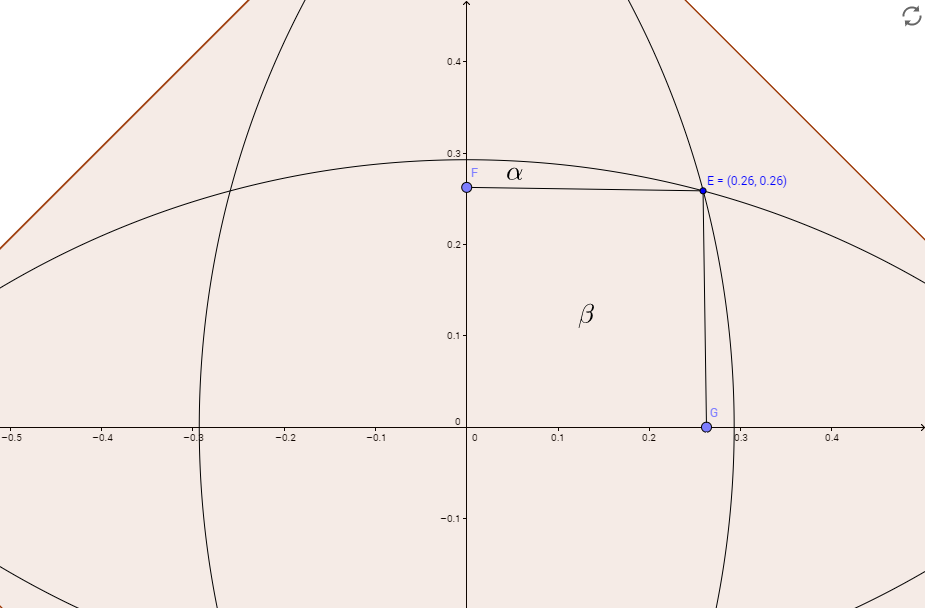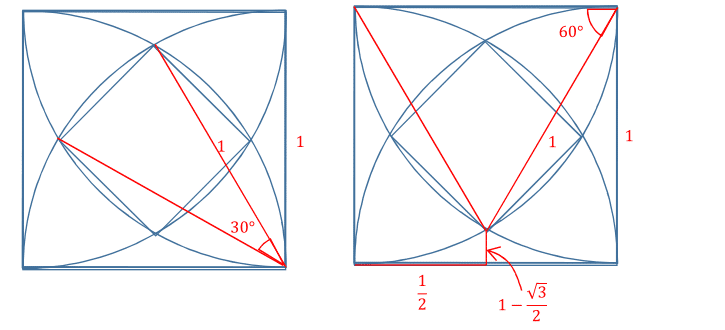Looks like an spherical square in the middle
A disc of radius 1 unit is cut into 4 quadrants. These are placed in a square of side 1 unit (these quadrants do not have any part outside the square). What is the least possible area of overlap shared by all quadrants?
If this area can be written as e a + b c + d π , where a , b , c d and e are integers , with c and e being positive, c being square-free and g cd ( a , b , d , e ) = 1 , find a b c d e .
The answer is -81.
This section requires Javascript.
You are seeing this because something didn't load right. We suggest you, (a) try
refreshing the page, (b) enabling javascript if it is disabled on your browser and,
finally, (c)
loading the
non-javascript version of this page
. We're sorry about the hassle.
4 solutions

On solving eqn. no. 4 and 5 from first graph, we get point of intersection of the circles E as ( 2 2 3 − 1 , 2 2 3 − 1 )
Required area is
8 α + 4 β = 8 ( α + β ) − 4 β = 8 ∫ 0 2 2 3 − 1 1 − x 2 − 2 1 d x − 4 ( 2 2 3 − 1 ) 2 = 8 [ 2 x 1 − x 2 + 2 1 sin − 1 ( x ) − 2 1 x ] 2 2 3 − 1 0 − ( 2 − 3 ) = 3 3 − 3 3 + π
What I have below is the Co-ordinate geometry approach, and hints.
Step 1: Draw 4 circles centered at (0,0) , (1,0) , (1,1) and (0,1) with their radii being 1. Also draw lines x=1 and y=1. We get that we make a figure similar to the one question describes when we look at the square formed by the co-ordinate axis and the lines x=1 and y=1.
Step 2: Find the intersection of the circles, the points which make the pints of the figure which looks circular square.
Step 3: Observe the Symmetry and divide the shape in 4 equal parts by drawing lines x=1/2 and y=1/2. And finally use integration to find the area contained between the one the four equal parts and the lines x=1/2 and y=1/2. And then multiply this value by 4.
The final answer turns out to be (pi - 3*sqrt(3) + 3)/3
 The overlapping region is composed of four circular segments with central angle
3
0
∘
and radius 1 (image on the left).
The overlapping region is composed of four circular segments with central angle
3
0
∘
and radius 1 (image on the left).
Area of one of the segments is A = 2 R 2 ( 1 8 0 α π − s i n ( α ) ) = 2 1 ( 6 π − 2 1 ) = 1 2 π − 3
Coordinates of the vertices of the square (image on the right), can be obtained as 2 1 and the difference between 1 and the height of an equilateral triangle with side 1 , which is 1 − 2 3 .
So the points are ( 2 1 , 1 − 2 3 ) and ( 1 − 2 3 , 2 1 ) and the distance between them is s = 2 3 − 1 . The area of the square is then s 2 = 2 ( 3 − 1 ) 2 .
Adding it all together A = 4 × 1 2 π − 3 + 2 ( 3 − 1 ) 2 = 3 π − 3 + 1 = 3 3 − 3 3 + π
So the area is 3 3 − 3 3 + 1 ∗ π = e a − b c + d ∗ π .
So abcde= - 3 3 3 1 3= - 81.